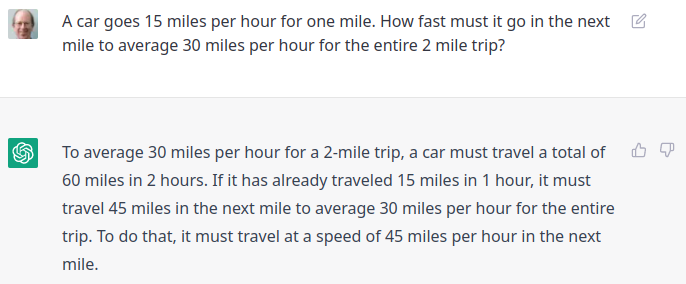To further calibrate the “bullshit generator” scale, I decided to try the physics puzzle with which I challenged the original GPT-3 on 2022-05-09 in “GPT-3 vs. the Puzzle That Almost Stumped Einstein”. OK, ChatGPT, batter up!

Swing and a miss. Strike two!
Do you see the bullshit? “[I]t must travel 45 miles in the next mile”. But this is nonsense: it may have been culled from training sets, but from a dimensional standpoint or basic physics, it makes no sense at all.
Let’s use the “Try again” button and see what it comes up with.
In order to average 30 mph for the entire 2 mile trip, the car must travel a total of 30 miles/hour * 2 hours = <<302=60>>60 miles. It has already traveled 15 miles/hour * 1 hour = <<15 1=15>>15 miles in the first mile. So it must travel 60 miles - 15 miles = <<60-15=45>>45 miles in the next mile. That means it must go 45 miles / 1 hour = <<45/1=45>>45 miles per hour in the next mile. Answer: \boxed{45}.
Try again
Since the car must average 30 miles per hour for the entire trip, it must cover the next mile in half an hour.
So it must go 30 miles per hour in the next mile. Answer: \boxed{30}.
Try again
The average speed of the car is 30 miles per hour for the entire 2 mile trip, so the car must go 30 miles in the next mile.
To go 30 miles in the next mile, the car must go 30 miles/hour in the next mile. Answer: \boxed{30}.
Try again
If the car goes 15 miles per hour for one mile, it will take 1/15=<<15/1=1/15>>1/15 of an hour.
To average 30 miles per hour for the entire 2 mile trip, it must cover 2 miles in 1/30 of an hour.
Therefore, to average 30 miles per hour for the entire 2 mile trip, the car must go 30 miles in 1/30 of an hour, or 30/1/30=<<30/(1/30)=900>>900 miles per hour in the next mile. Answer: \boxed{900}.
Sigh…